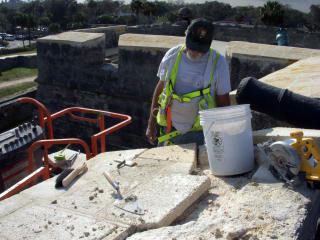





 |
The Workshop
Fort Sumter National Monument hosted over 75 participants from more than fifteen National and State parks at the Preserving Coastal Forts: a National Park Service (NPS) Workshop held April 8-10, 2008 in Charleston, South Carolina. Park Superintendents, Cultural Resource and Facility Managers, Architects and Engineers, Masons and Maintenance Mechanics, contractors and partners attended.
Stewardship of Coastal Forts
The Superintendents of Fort Sumter, Fort Pulaski, and Castillo de San Marcos offered opening remarks shaping the challenges facing the stewards of coastal fortifications. They encouraged the workshop participants to learn from their results, share their knowledge and develop networks to inform future work. Cultural Resources Manager, Sandy Pusey-Cameron, outlined the scale of the preservation needs for the 59 NPS units that contain fortifications: there is more than $510M in deferred maintenance and $50M for fortification work now formulated for funding in the next five years.
Hands-On Learning
The first day of the workshop participants visited Fort Moultrie where demonstrations by masons from the Historic Preservation Training Center (HPTC) and the maintenance staff from Fort Pulaski, assisted by students from the Savannah Collage of Art and Design, offered the participants “hands-on” learning about historic mortars. A field trip the following day to Fort Sumter provided the venue for a practicum, lead by building forensic engineers, on the effectiveness of waterproofing systems used at the fort.
Best Practices
Over the course of three days, Workshop presenters addressed “Lessons Learned” topics that included: recently completed brick masonry work at Forts Washington and Jefferson; results gained from developing and implementing treatment plans for concrete batteries within Golden Gate NRA, using building science to inform treatment decision making, plans for future work at Fort Jay and Castle William at Governors Island, using goats to control vegetation at Battery Weed at Fort Wadsworth within Gateway NRA, and controlling moisture at Fort Delaware State Park. Other guest speakers covered hurricane recovery work on forts at Gulf Island National Seashore and “Best Practices” derived from the sustained efforts to preserve the masonry at Castillo de San Marcos in St Augustine, Florida.
Practical Solutions
The presentation given by the primary author of the Fortification Preservation Handbook, David Hansen, was for many participants the highlight of the workshop. His case study summarized the work to restore Battery Worth at Fort Casey, a Washington State Park. His example of balanced practical solutions to numerous technical obstacles inspired many in the audience.
|









I have heard somewhere that a hot shot furnace from Fort Pulaski was dismantled and sent to another fort, is this true?